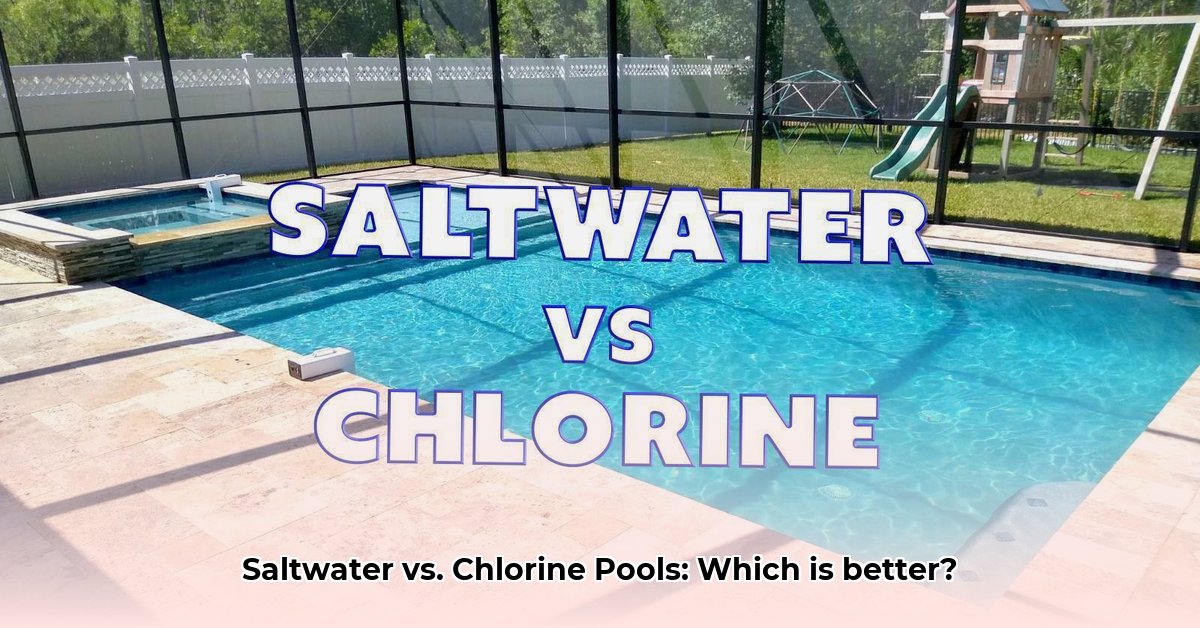
Choosing between a saltwater and chlorine pool can be daunting. This guide provides a comprehensive comparison, helping you make an informed decision based on your needs and budget. We'll cover upfront and ongoing costs, maintenance requirements, swimming experience, and environmental impact, guiding you through the process of choosing and maintaining your perfect pool.
Upfront Costs: Initial Investment
The initial investment significantly differs between saltwater and chlorine pools. Chlorine pools typically have lower upfront costs, requiring mainly a basic filtration system and a supply of chlorine. Saltwater pools, however, necessitate a saltwater chlorinator, substantially increasing the initial expense. This added cost reflects the more complex technology involved in generating chlorine from salt. Consider this the "luxury vs. economy" choice for your pool's initial budget.
Long-Term Costs: Ongoing Expenses
While chlorine pools boast a cheaper initial setup, long-term operating expenses often favor saltwater. Salt refills are necessary, but the cost is generally far less than continuous chlorine purchases. However, both systems require ongoing chemical balancing, impacting long-term costs for both. The overall long-term savings of a saltwater pool depend greatly on your region’s electricity prices and the lifespan of the chlorinator. This aspect needs careful consideration, weighing the smaller initial investment against the potentially higher cost of continuous chemical additions.
Maintenance: Time and Effort
Regular cleaning is essential for both saltwater and chlorine pools. However, saltwater systems demand additional maintenance: periodic cleaning of the chlorinator cell. Chlorine pools, conversely, need consistent chemical additions to maintain proper sanitation. Hence, it's a trade-off: less frequent but potentially more involved tasks versus a daily routine of adding chemicals. This is key when evaluating the convenience factor of each system.
Swimming Experience: Comfort and Feel
Many find the water in saltwater pools gentler on skin and eyes, leading to a more comfortable swimming experience. However, this is subjective; proper chemical balancing in both systems is critical for a pleasant swim. If skin or eye sensitivity is a concern, prioritize thorough chemical balancing regardless of pool type. Even a perfectly balanced chlorine pool can provide excellent comfort.
Environmental Impact: Considering Sustainability
Both pool types have environmental implications. Chlorine pools introduce chemicals directly into the environment, while saltwater pools consume electricity to power the chlorinator. The complete environmental impact of each system is a subject of ongoing research. Ultimately, responsible maintenance practices for either pool are essential, minimizing environmental effects.
Choosing Your Pool: A Step-by-Step Guide
Prioritize Your Needs: Budget constraints, available maintenance time, chemical sensitivities, and local climate heavily influence your choice. Consider your priorities carefully.
Professional Consultation: Obtain quotes from several pool installers. Don’t hesitate to ask detailed questions about both systems to ensure a fair comparison.
Installation Details: Both installations need careful planning, including electrical work, plumbing, and proper grounding. Local regulations and specific site conditions should be accounted for.
Maintenance Schedule: Develop a checklist for ongoing maintenance, covering cleaning, chemical balancing, and equipment checks. Regularity is crucial for pool health and safety.
Troubleshooting Knowledge: Familiarize yourself with common issues and solutions for both systems. This proactive approach can prevent costly repairs and maintain optimal pool function.
Troubleshooting Common Issues
Saltwater Systems:
- Chlorinator Malfunction: Check salt levels, clean the cell, and verify water flow. A malfunctioning cell might necessitate professional service.
Chlorine Pools:
Low Sanitizer Levels: Regularly test water; low levels are easily corrected by adding chlorine.
Cloudy Water: Cloudiness typically indicates chemical imbalance or algae growth. Use algaecides and clarifiers; consult a professional if the issue persists.
Risk Assessment: Potential Challenges
| Technology/System | Risk Factor | Severity (1-5) | Mitigation Strategy |
|---|---|---|---|
| Saltwater Generator | Cell failure/corrosion | 4 | Regular cleaning, timely replacement, proper water balancing |
| Saltwater System | Component corrosion | 3 | Corrosion-resistant materials; regular inspection |
| Chlorine Handling | Accidental exposure | 5 | Safe storage, proper handling procedures, protective gear |
| Chlorine Pool | Chemical imbalance | 4 | Regular water testing, precise chemical additions |
Regulatory Information and Considerations
Local regulations concerning pool construction, safety, and chemical usage vary significantly. Consult local authorities before beginning any pool installation. Obtain necessary permits and ensure compliance with all applicable codes and ordinances.
Conclusion: Making the Right Choice
The optimal choice depends entirely on individual circumstances. Weigh the pros and cons carefully, aligning your decision with your priorities and resources. Thorough planning and informed research are key to years of enjoyment in your new pool.